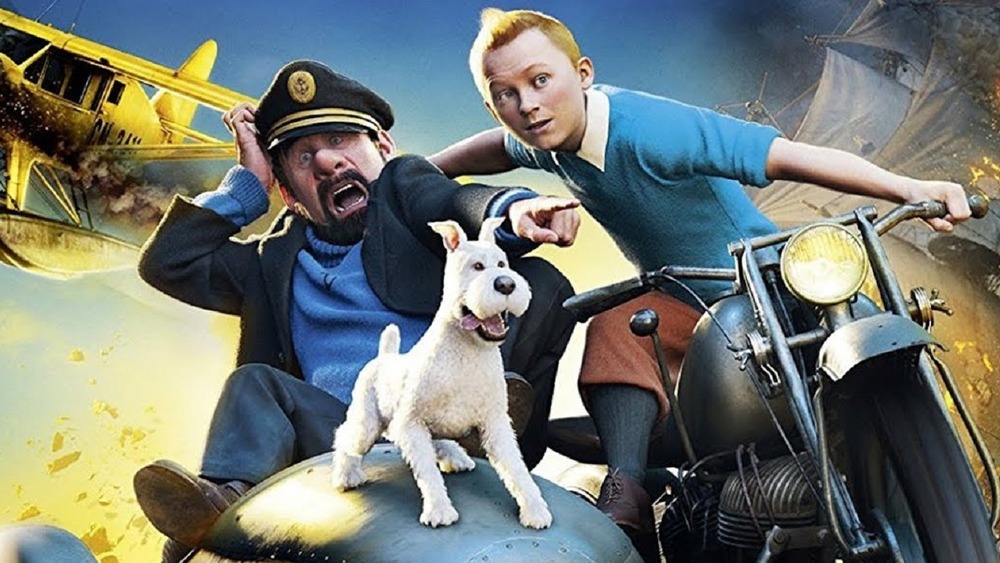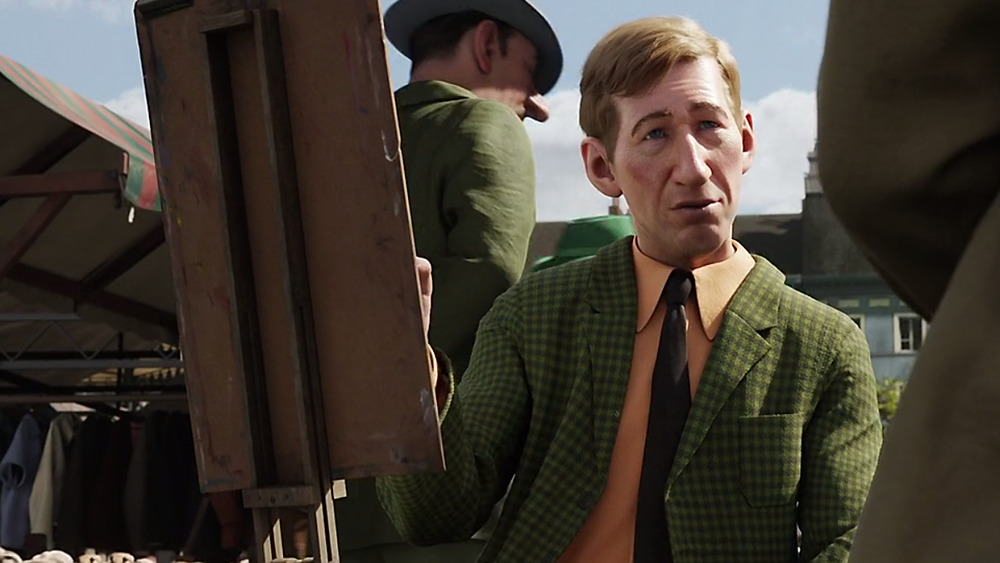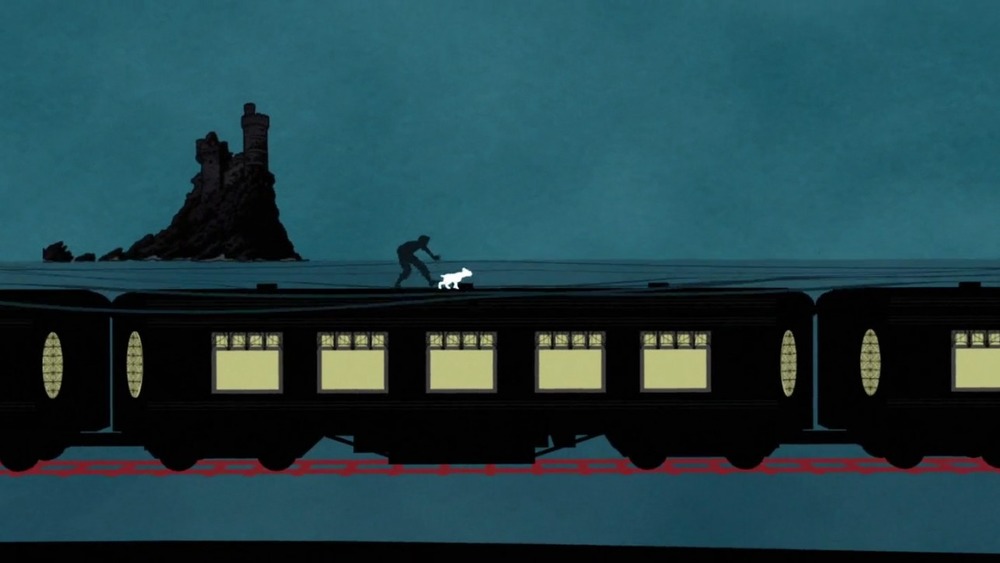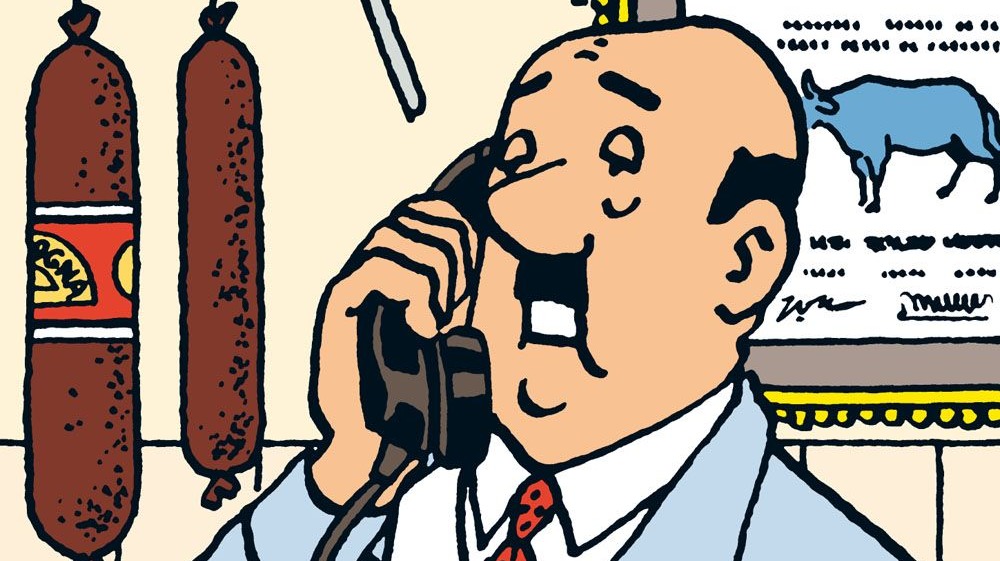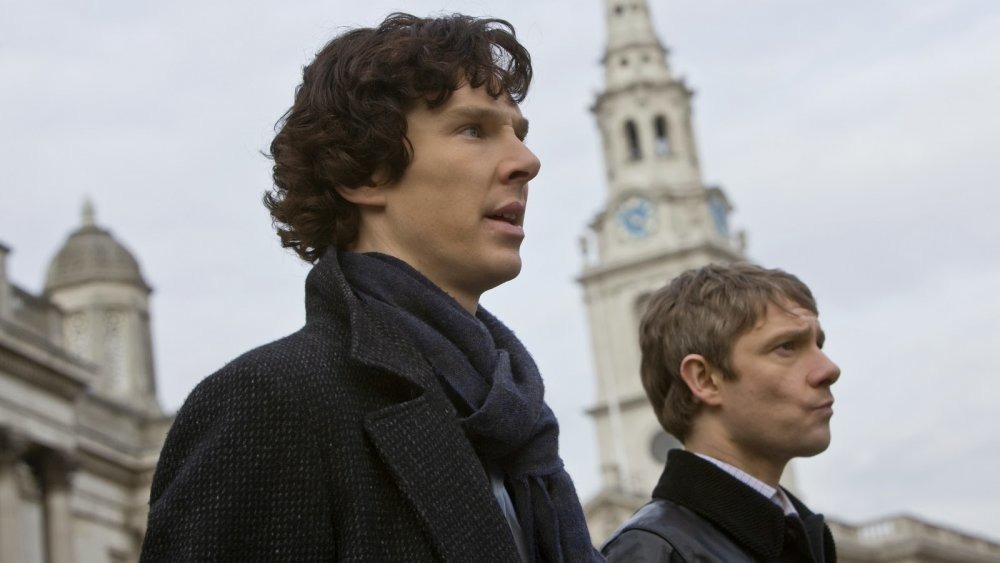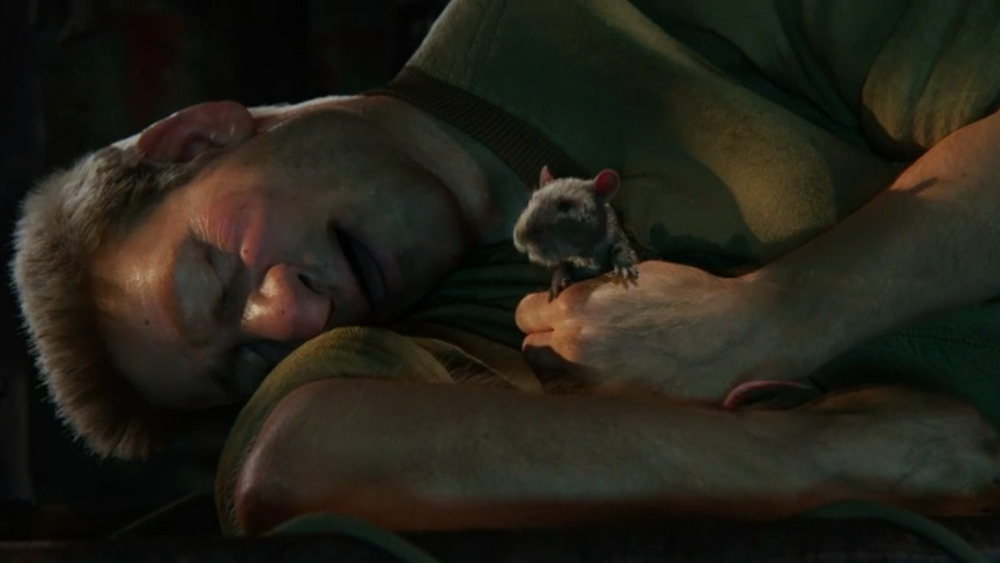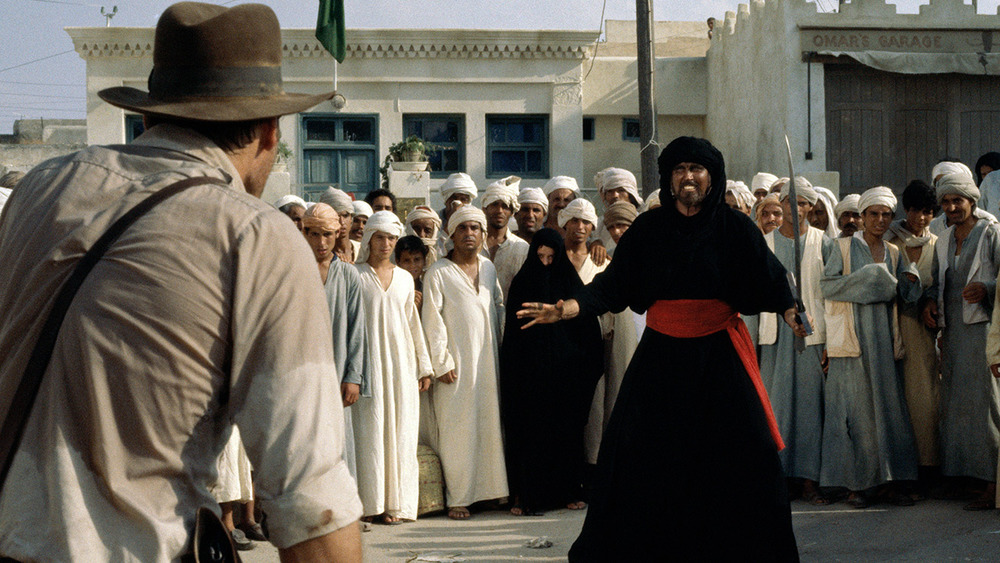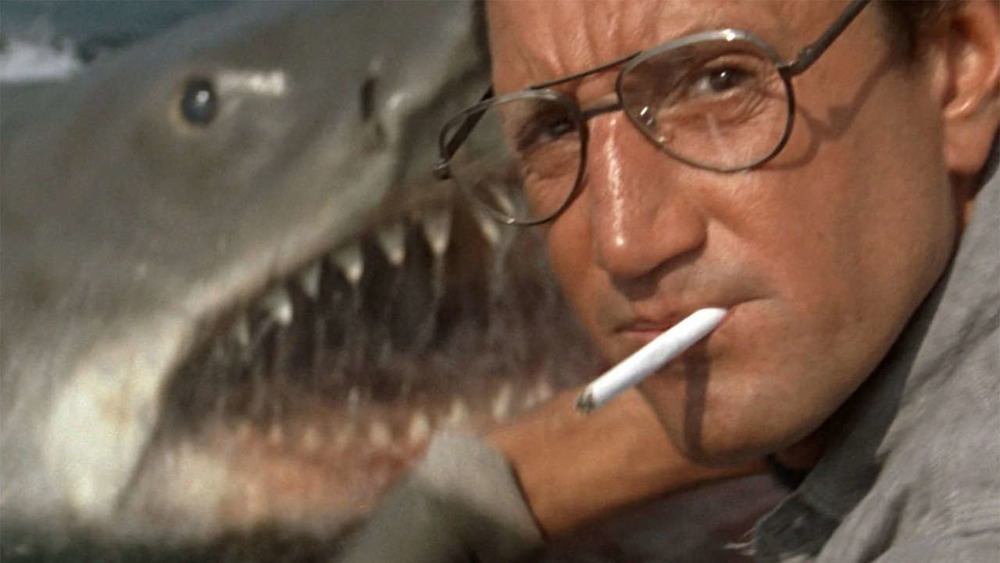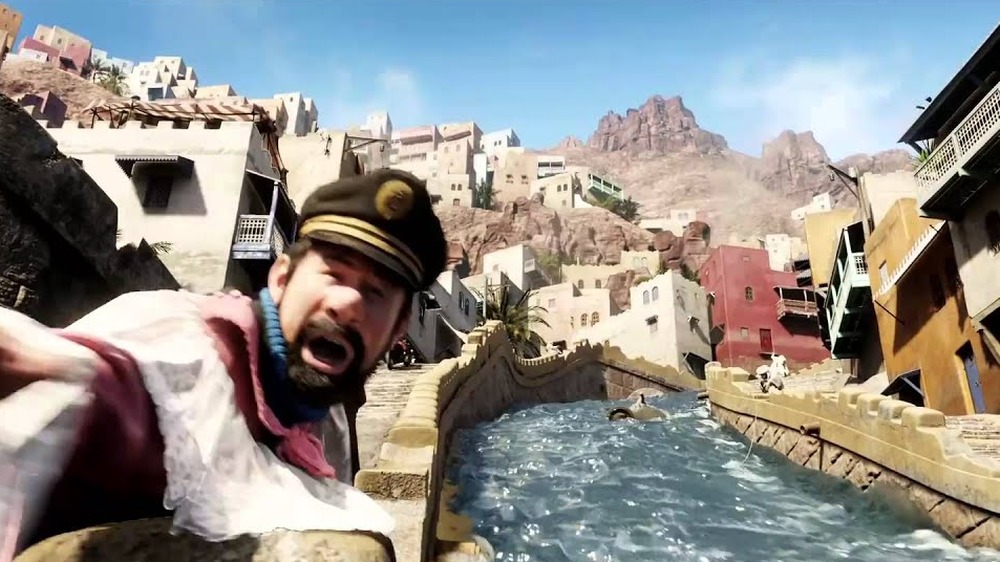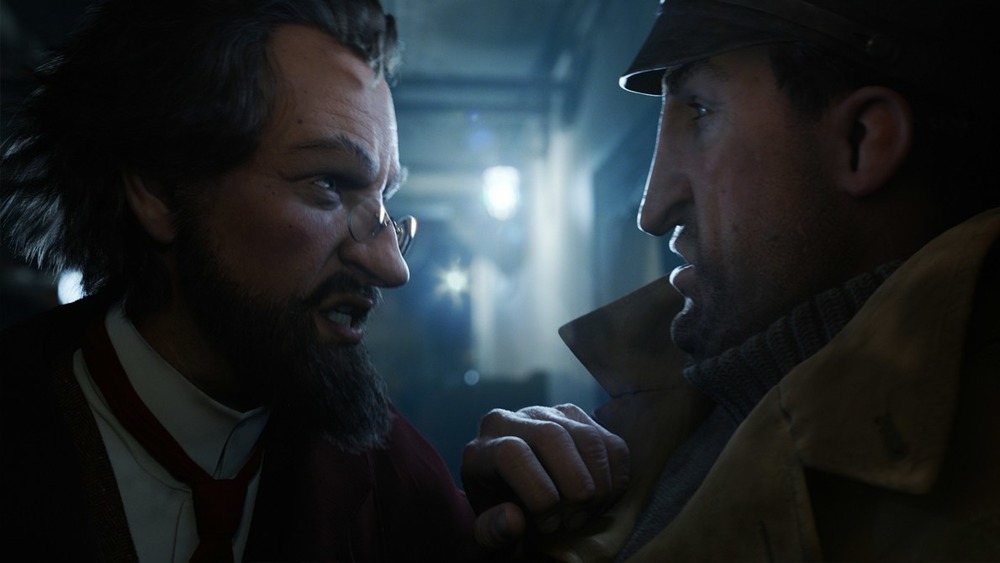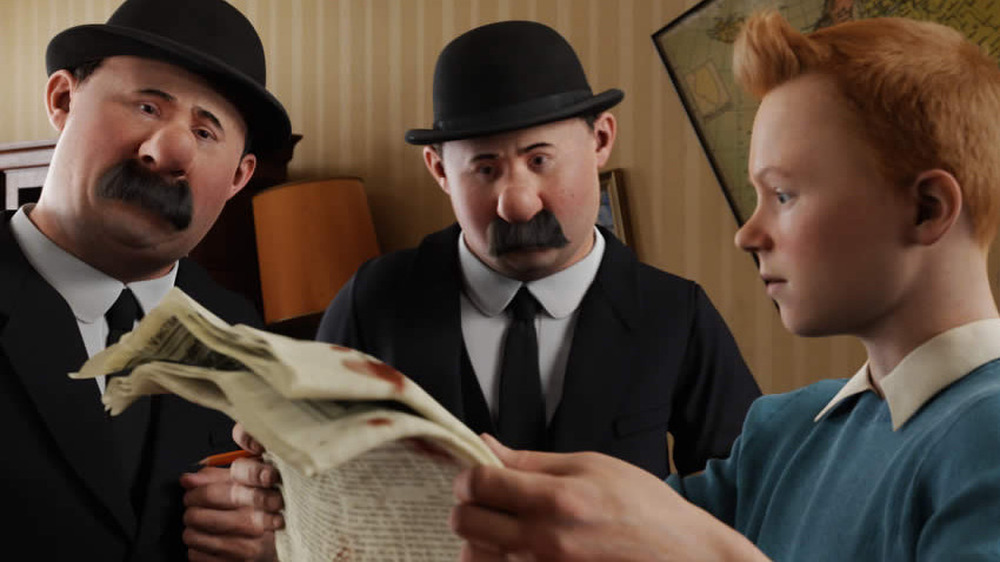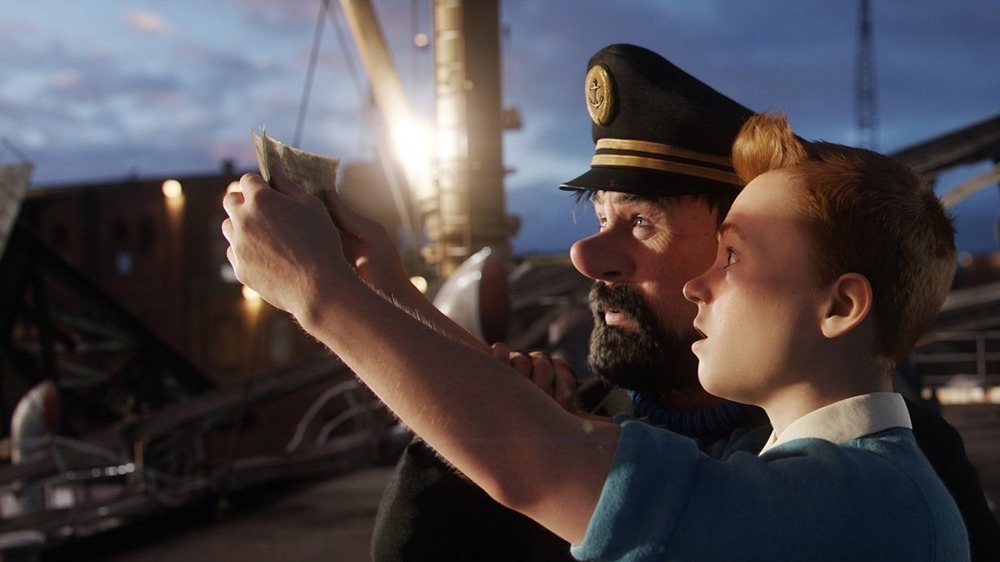Things Only Adults Notice In The Adventures Of Tintin
We need to quit calling great action movies "thrill rides," not just because it's a cliché but because after The Adventures of Tintin, no other movie can live up to it. The animated story of Tintin (Jamie Bell), a daring young reporter searching for lost treasure with the help of his dog Snowy and the washed-up Captain Haddock (Andy Serkis), never stops throwing wondrous images in viewers' faces.
There's the spectacularly realistic rendering of faraway places in long-ago times, from a European port town to the Sahara desert to a North African city that hasn't aged a day after a decade's worth of technical advancement. And then there's the action that director Steven Spielberg fills that world with — fencing battles with industrial cranes, a pirate ship swinging from the mast of its quarry as cutthroats jump from one deck to another, and a chase between a falcon and a motorcycle that morphs into a unicycle. And that's not even mentioning the tank that turns a hotel into a rolling fortress.
In other words, it's got everything kids will love, but if adults can pick their jaws off the floor long enough to slow down and examine the details, they'll find plenty of subtler pleasures under the flash to hold their interest. Here are just a few of them.
Tintin's creator has a cameo
Tintin's comic book adventures have been beloved all over the world ever since Belgian artist Hergé first drew him for the children's magazine Le Petit Vingtiéme in 1929. If that name seems familiar, that's because it shows up in the film. Where at? It's the masthead on the newspaper that the dying Interpol agent uses to spell out a final message for the hero. And that's just the beginning of the references Spielberg has hidden throughout Tintin for adults who grew up on the character's stories.
You could say Hergé's all over every scene of The Adventures of Tintin, some more literally than others. We first see Tintin at a flea market sitting for a caricature. The artist says, "Somehow, I think I've drawn you before," and he's right. The caricaturist is a dead ringer for Hergé himself. He then returns a portrait to Tintin that looks exactly like our hero appears in the books — a simple, smiley face-like figure who's very different from the motion-capture-assisted detail of the movie's Tintin.
The references don't end there. The caricaturist is surrounded by portraits of past clients, all of them taken from the original comics, and they should be familiar from the endpapers of the Little Brown editions that have kept Tintin in print in the States for decades.
The credits are full of Tintin Easter eggs
Many of the best callbacks to Hergé's books are right at the beginning of the film, in a credits sequence animated with silhouettes and bold colors in a much simpler style than the film's groundbreaking mo-cap. There are bits and pieces of Hergé's original art scattered throughout, like the stars that erupt from Tintin's head when he's cold-cocked or the original cover of the Secret of the Unicorn story that inspired the movie. The credits also feature a loose plot of Tintin tracking the thief of a glowing orb that looks identical to the ones from Hergé's The Seven Crystal Balls.
One scene also takes him to a train station, and if you pause at the right moment, you'll find it's packed full of hidden callbacks, with every destination on the departures board — from the real (Tibet) to the invented (Syldavia), from the mundane (Hergé's hometown, Brussels) to the fantastical (the moon). In the next scene, Tintin chases the bad guys onto a train that speeds past images from the Tintin books, including the rocket from Destination Moon, the title location of The Black Island, and the Olmec head from Flight 714. There are plenty more Easter eggs, but we won't spoil them all for you. Just pick up a stack of Tintin books, and give the movie another look.
The cows belong to a butcher who'll be familiar to Tintin fans
Everything in Tintin's computer-animated world had to be created from scratch, so it only makes sense that the army of designers and technicians necessary to bring it to life would include some private jokes to make all that work more fun. This means you'll want to keep a close eye on any signs and writing in the background.
For instance, when Captain Allan and his thugs load Tintin into a crate to take him away on their ship, Snowy chases them down across the docks, dodging traffic and cutting his way through a cattle pen as he runs after the bad guys. On his way, Snowy passes a shop belonging to "E. Cutts, Butcher." It's a clever pun since he sells cuts of meat, and it's one that should be familiar to Tintin fans.
Ever since The Calculus Affair in 1954, Hergé kept up a running joke of Captain Haddock getting interrupted by phone calls at increasingly inconvenient times that turn out to be a wrong number for Mr. Cutts the butcher. The filmmakers got the character's English name from translators Leslie Lonsdale-Cooper and Michael Turner, but his name is just as punny in the original French, where he's called Sanzot, a play on sans os (boneless).
There are references to another classic adventure hero
Tintin's been around a long time, but he's still a long way from being the first fictional hero to travel the globe solving mysteries. That long lineage includes Sir Arthur Conan Doyle's great detective Sherlock Holmes, and The Adventures of Tintin tips its hat to its forebear.
Doyle's stories featured Homes' longsuffering landlady, Mrs. Hudson, a dowdy old woman who was frequently shocked by Holmes' eccentric habits. The Adventures of Tintin includes a speaking role for Tintin's dowdy old landlady Mrs. Finch. And Mrs. Hudson could take some notes from her easygoing attitude to Tintin's shenanigans. When he tells her, "A man's been shot on our doorstep," her only response is, "What, again?"
You could spend some time arguing over whether Mrs. Finch's appearance is an intentional reference or not, but there's another unquestionable Holmes callback a few scenes later. To escape from the hold where the bad guys have trapped him, Tintin climbs up to Captain Haddock's cabin, but not before he tosses Snowy up ahead of him. There's nothing unusual about the little white dog, but Haddock's so sloshed the sight terrifies him, and he shouts, "The giant rat of Sumatra!"
He's apparently been reading his Doyle. The name comes from "The Adventure of the Sussex Vampire," where Holmes recalls "a ship which is associated with the giant rat of Sumatra, a story for which the world is not yet prepared." Apparently, the world never was prepared for that story, since Doyle never wrote it.
At least one joke isn't for kids
A lot of Tintin's jokes will go right over kids' heads, and there are other jokes that parents will just have to hope they don't get. There's one in particular that's so filthy that it's hard to imagine it would make it to the screen even in an R-rated movie if it weren't so obscure.
After helping Haddock escape from his cabin (it wasn't locked, he just assumed it was), Tintin finds that a storeroom full of supplies necessary for their escape actually is locked. This means he has to sneak into the sleeping quarters and steal the keys, all without waking the collection of deadly cutthroats snoozing away in the bunks. Haddock especially warns Tintin about Mr. Kitsch because, "He was sacked as a shepherd on account of his ... animal husbandry."
That pause and Haddock's disgusted expression suggest there's something euphemistic going on, and it's hard to imagine it's anything but some X-rated sheep-shagging. That certainly adds some queasy undertones to the way Kitsch is snuggling up with an uncomfortable rat while he sleeps. It's hard to imagine how they got away with this one — but that's what makes it so funny.
It's familiar ground for Spielberg
The Adventures of Tintin was a special treat for grown-up cinephiles as a showcase for Steven Spielberg, one of the most important directors in Hollywood. He's racked up classics from Jurassic Park and Jaws to Schindler's List and E.T. But one part of his career will definitely be on viewers' minds while watching Tintin – the Indiana Jones films.
Those movies also took a globetrotting hero across a world that existed before World War II really started, all in search of ancient treasures, with characters traveling by seaplanes and rusty iron ships. And if the fictional sultanate of Bagghar isn't the same as the Egyptian city Indy traveled to in Raiders of the Lost Ark, it's not too far off, either. Plus, Tintin narrowly escapes the fate of Raiders' Nazi mechanic when he passes out next to a propeller. And both movies even feature a secret message that's only visible when the sun hits an age-old artifact just right.
That's no coincidence. The Philippine Daily Inquirer reports Spielberg's love of Tintin began with the release of Raiders of the Lost Ark, which one critic at the time compared to Hergé's comics. Spielberg had never heard of Tintin before, but soon he was hooked, and he spent the next several decades trying to bring it to the big screen, beginning with a 1984 production that would've starred Jack Nicholson as Captain Haddock. Those dreams finally came true in 2011 — minus Nicholson — and it was more than worth the wait.
Tintin plays another Spielberg character
Throughout Tintin, Spielberg throws in some references to his own career. Most of them won't be familiar to kids, but adults will have a ball catching them all.
For instance, Spielberg announced his arrival as a major talent in 1975 with Jaws, which smashed box office records and changed the way films were made and marketed forever. Jaws stars Roy Scheider as Martin Brody, police chief of a sleepy New England resort town that comes under attack from a gigantic killer shark. After some grisly and horrifying murders, he sails out with Richard Dreyfuss as scientist Matt Hooper and Robert Shaw as crusty old fisherman Quint to kill the beast. But the real star is the shark itself, which stays mostly offscreen, making its presence felt by absence. Until the climax, we only see the great white one piece at a time, most famously in the scene of its dorsal fin racing towards some helpless swimmers.
Over in Tintin, after escaping the villainous Sakharine's ship, Tintin, Snowy, and Haddock find the evil treasure hunter has sent his men to retrieve them so he can unlock the secrets of Haddock's family treasure. Sakharine's men strafe the hero's lifeboat from a plane until Tintin shoots it down so he can commandeer it and fly it to safety. As the bad guys try to repair their engine, Tintin swims aboard, hidden underwater except for the trademark quiff of hair shooting up from his head, looking just like the shark's sinister fin.
The camerawork is impossibly good
After 50 years and a staggering number of movies, you wouldn't think there'd be any new ideas left for Spielberg to try. But Tintin obviously energized the then-65-year-old director because the movie is more kinetic and restlessly inventive than almost anything else he's made.
A lot of that comes from his move to animation. Instead of a big, bulky camera, Spielberg gets to work with one that's literally weightless because it only exists in computer code. That means he can do all kinds of tricks that would be impossible in live-action. The simulated "camera" can begin a shot zoomed all the way in on the reflection in a pirate's sword and then move all the way out until both ships look as small as bathtub toys. It can begin one shot behind the controls of a crane, then move straight through the windshield all the way across the docks and behind the windshield of another as smoothly as if the glass didn't exist ... because it doesn't.
Most spectacular of all, there's the chase scene in Bagghar, which goes on for nearly five minutes without a cut. Normally, this means we'd be stuck looking from the same perspective the whole time. Even the most ambitious live-action filmmaker couldn't cover any more space than they could lay down tracks for. Tintin doesn't have any of those limitations. That one shot covers miles of space, jumping up into the sky and darting seamlessly in and out of buildings.
James Bond plays a Bond villain
Spielberg isn't the only major player involved in bringing Tintin to the screen. The movie also features an all-star cast, including Daniel Craig as Sakharine and his buccaneer ancestor, Red Rackham. Sakharine is a classic villain, an erudite world traveler, well-dressed and soft-spoken but deadly with the sword he's concealed inside his cane. In other words, he could easily pass for the classic Bond villain. All he's missing is a cat to stroke, and his falcon makes a good substitute.
So it's a sly joke to give him the voice of James Bond himself. Craig first stepped into the role in 2006's Casino Royale, with No Time to Die being his fifth go-round as the British superspy. And that's just one piece of a long career that started with his breakout role in the BBC series Our Friends in the North and his Hollywood breakout with the very Tintin-esque Lara Croft: Tomb Raider. He also starred in Spielberg's Munich, and he only became more bankable after donning the 007 tux. And if you walked into the theater when Tintin premiered in December 2011, you could step across the hall to see Craig again in The Girl with the Dragon Tattoo. More recently, he had a show-stopping role as the Southern-fried master detective Benoit Blanc in Knives Out.
It's a Cornetto trilogy reunion
Tintin gets some help in his adventures from two bumbling Interpol agents named Thomson and Thompson. They may look identical with their bowler hats, mustaches, and canes, but thanks to the magic of motion capture, they're portrayed by two actors who've made a career of playing their very different body types off each other.
Yeah, it's portly Nick Frost and thin Simon Pegg. Audiences first saw them together in the British sitcom Spaced, where they played two London slackers who've been friends since childhood. They then collaborated with series creator Edgar Wright on the "rom-zom-com" Shaun of the Dead, where their characters try to survive the zombie apocalypse and hopefully get Shaun (Pegg) back together with his girlfriend (Kate Ashfield).
This began the "Cornetto trilogy," a series of collaborations between the stars and the director, all of them including product placement for the titular ice cream makers. Next was Hot Fuzz, where they played two cops who discover a deadly conspiracy in a sleepy British village, followed by The World's End, a bittersweet but hilarious story where a bunch of school friends reunite to recreate their pre-graduation pub crawl ... even after they discover an alien invasion.
There's serious talent behind Tintin's script
Tintin's script is credited to three writers, each one of them a star in his own right. First up, there's Edgar Wright, who — along with the Cornetto trilogy — directed the cult classic Scott Pilgrim Versus the World, where slacker hero Scott (Michael Cera) discovers that by dating Ramona Flowers (Mary Elizabeth Winstead), he's signed himself up to defeat her seven evil exes. Then he directed Baby Driver, a combination heist film and feature-length music video.
Also on writing duties is Joe Cornish, the writer-star of the sketch comedy The Adam and Joe Show. He stepped into the director's chair the same year Tintin premiered with Attack the Block, which introduced Star Wars star John Boyega to the world. He followed that up with The Kid Who Would Be King in 2019, an updated Arthurian legend where British tweens discover Excalibur and the responsibilities that come with it.
Completing the credits is Steven Moffatt, who's been writing for British TV for three decades. Highlights include writing on Doctor Who before graduating to showrunner in 2010. And at the same time he was doing that, he was also bringing another iconic hero to new heights of popularity as the creator of Sherlock, starring Benedict Cumberbatch as Holmes and Martin Sheen as Watson. So yeah, it seems like a safe bet the Holmes references in Tintin are his work.
